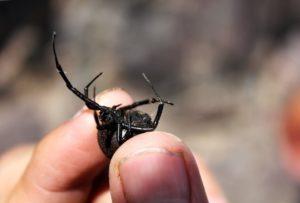Black spider karakurt: small, but remote
The Karakurt spider is one of the poisonous representatives of the Black Widow species that lives in the European part of the country. Like all representatives of its species, the female Karakurt kills her partner after mating.
Content
Description of the spider
Name: Karakurt
Latin: Latrodectus tredecimguttatusClass: Arachnida - Arachnida
Squad: Spiders - Araneae
Family: Tenetiki - Theridiidae
 | Habitats: | grass, ravines, fields |
 | Dangerous for: | small insects |
 | Attitude towards people: | bites, venomous |
On the underside of the abdomen, females have a red pattern, in the form of an hourglass, or two vertical stripes. The velvety body is covered with forked hairs.
The male differs from the female not only in size, but sometimes his body can be black with a brownish tint and white spots. The animal has 4 pairs of black legs, they are long and strong.
Distribution
The Karakurt spider lives in Southern Europe, Northern parts of Africa and Asia. In Russia, it is found in territories from the European part to the southern regions of Siberia.
Its favorite places of settlement are grassy places, meadows, arable lands and open arid areas. It is found in sheds, in gardens and even in people's dwellings. Karakurt can be seen on rocky and sandy shores.
The number of individuals of this species differs from year to year, but with a frequency of 10-12 or 25 years, a surge in the number of arthropods is observed.
Lifestyle and reproduction
The spider weaves its webs on the ground, the trapping threads are stretched in different directions, and above them, in the form of a key, a shelter is made in which it stays at night. Usually karakurt makes a web in the grass or between stones.
In the laboratory, spiders appear on day 49, in nature this period lasts a little longer. Karakurt eggs are toxic, like other spiders of this species.
The female migrates in May-June, finds a secluded place and makes temporary mating nets, and the mature male searches for her. Once in the web, the male does not leave it anymore.
After the last molt, the female becomes sexually mature, the male ties her with a web and mates with her. After that, the female is quickly released from captivity, and eats the male.
After mating, she makes a lair, weaves up to 5 cocoons, in each of them she lays from 100 to 700 eggs and hangs them in her dwelling. Initially, the cocoons are white or cream in color, then, closer to the appearance of offspring, they become yellow.
Juveniles appear in April and are dispersed by the wind with cobwebs. Before becoming adult sexually mature individuals, they go through several stages of molting, females - 8 times, males - 4-5 times.
Females live until November, their lifespan is about 302 days, males die in September, their lifespan is about 180 days.
Danger to humans and animals
Karakurt rarely attacks first, and if disturbed, he tries to run away. He bites in extreme cases. But his bite can be fatal to a person if medical assistance is not provided in time. Its venom consists mainly of neurotoxins.
- After a bite, after 10-15 minutes, a person feels a burning pain that quickly spreads throughout the body and causes unbearable pain in the chest, abdomen, and lower back.
- Abdominal muscles tighten sharply. Shortness of breath, dizziness, vomiting, sweating, flushing of the face, headache, and tremors may occur.
- In the later stages of poisoning, depression, blackout of consciousness, and delirium may occur.
For treatment, anti-karakurt serum or intravenous injections of novocaine, calcium chloride and magnesium hydrosulfate are used. If you immediately burn the place of the spider bite with a match, then the effect of the poison can be weakened.
Karakurt is active at night; a hanging canopy with well-tucked edges under the bed can protect a sleeping person from a spider attack.
Recently, cases of bites by Karakurt have become known in Azerbaijan, the Rostov region, in the south of the Urals, in Ukraine.
Safety measures
The web and the spider itself is on the ground, and in those areas where it lives, it is important to use reliable closed shoes. Also, the spider weaves its webs in the grass, before starting work in the garden, you need to carefully examine the territory for the presence of cobwebs. There were cases when the spider settled in shoes left on the site.
The karakurt often makes its web in the hoof marks of domestic animals in pastures. Livestock often suffer from its bites. For horses and camels, the poison of karakurt is especially dangerous, and usually these animals die after being bitten.
Interestingly, sheep and goats are immune to spider bites.
Enemies of Karakurt
Despite the fact that the spider itself is dangerous for many insects, under natural conditions, its enemies are wasps, riders, and hedgehogs. Also, its masonry is trampled by grazing domestic animals.
https://youtu.be/OekSw56YaAw
Conclusion
Karakurt is a poisonous spider that lives over a large area. He himself does not attack first, but his bite is poisonous and can be fatal. By taking precautions in its habitat, the danger of a spider attack can be minimized.
Previous